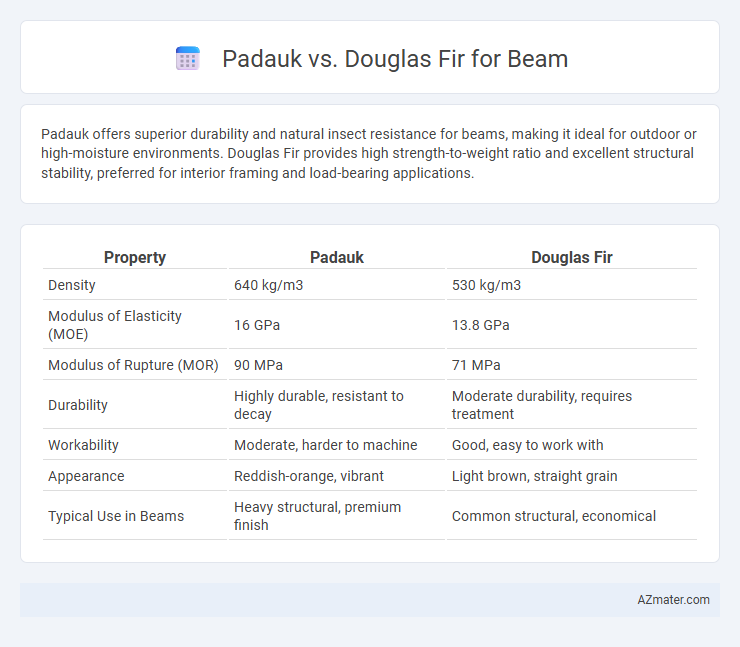Padauk offers superior durability and natural insect resistance for beams, making it ideal for outdoor or high-moisture environments. Douglas Fir provides high strength-to-weight ratio and excellent structural stability, preferred for interior framing and load-bearing applications.
Table of Comparison
| Property | Padauk | Douglas Fir |
|---|---|---|
| Density | 640 kg/m3 | 530 kg/m3 |
| Modulus of Elasticity (MOE) | 16 GPa | 13.8 GPa |
| Modulus of Rupture (MOR) | 90 MPa | 71 MPa |
| Durability | Highly durable, resistant to decay | Moderate durability, requires treatment |
| Workability | Moderate, harder to machine | Good, easy to work with |
| Appearance | Reddish-orange, vibrant | Light brown, straight grain |
| Typical Use in Beams | Heavy structural, premium finish | Common structural, economical |
Introduction to Padauk and Douglas Fir Beams
Padauk beams, renowned for their rich reddish-orange hue and exceptional hardness, offer superior resistance to decay and insect damage, making them ideal for durable structural applications. Douglas Fir beams are prized for their exceptional strength-to-weight ratio, straight grain, and excellent load-bearing capacity, commonly used in heavy construction and framing projects. Comparing these woods highlights Padauk's aesthetic appeal and natural durability against Douglas Fir's structural strength and availability for beam construction.
Origin and Availability of Padauk and Douglas Fir
Padauk, native to tropical regions of Africa and Southeast Asia, is known for its vibrant reddish-orange hue and dense grain, making it less commonly available outside specialty lumber markets. Douglas Fir, abundant in the Pacific Northwest of North America, is widely accessible due to its extensive commercial forestry operations and is prized for its strength and versatility in construction beams. The widespread availability of Douglas Fir contrasts with the more limited, region-specific supply of Padauk, affecting project sourcing and cost considerations.
Physical Properties: Density and Hardness Comparison
Padauk exhibits a density of approximately 800 kg/m3 and a Janka hardness rating near 1,750 lbf, making it a highly durable and dense timber ideal for beams requiring strength and wear resistance. Douglas Fir has a lower density around 530 kg/m3 and a Janka hardness of about 660 lbf, providing moderate strength with lighter weight, suitable for structural beams where weight is a consideration. The significant difference in density and hardness between Padauk and Douglas Fir impacts load-bearing capacity and longevity in beam applications, with Padauk offering superior durability but increased weight.
Strength and Structural Performance
Padauk wood exhibits exceptional strength and durability, making it suitable for heavy-load applications, with a Janka hardness rating of approximately 1,750 lbf and excellent resistance to wear and decay. Douglas Fir, widely used in construction, offers a high strength-to-weight ratio, with a modulus of rupture of around 12,100 psi and a modulus of elasticity near 1.9 million psi, providing reliable structural performance for beams and framing. While Douglas Fir is favored for its consistent grain and predictable mechanical properties, Padauk's greater density and hardness contribute to superior resistance to compression and impact, making it ideal for beams requiring enhanced load-bearing capacity and longevity.
Durability: Resistance to Decay and Insects
Padauk exhibits exceptional durability with high resistance to decay and insect attacks, making it ideal for structural beams in harsh environments. Douglas Fir offers moderate durability but requires treatment to enhance its resistance against rot and pests. The natural oils in Padauk contribute to its superior performance in outdoor and moisture-prone applications compared to the more commonly used Douglas Fir.
Workability: Machining, Cutting, and Finishing
Padauk offers excellent workability for beams, with smooth machining and cutting properties due to its medium density and uniform grain, allowing for precise detailing and reduced tool wear. Douglas Fir, being softer and less dense, machines and cuts easily but may require more care during finishing to avoid splintering and uneven surfaces. Finishing Padauk results in vibrant, rich colors with good polish adherence, while Douglas Fir typically absorbs finishes well but may need extra sanding to achieve a smooth, consistent look.
Appearance and Aesthetic Appeal
Padauk beams exhibit a striking reddish-orange hue that deepens over time, providing a vibrant and exotic aesthetic ideal for bold interior designs. Douglas Fir offers a warm, golden-brown color with straight, uniform grain patterns, lending a classic and natural look suited for traditional and rustic settings. The choice between Padauk and Douglas Fir hinges on desired visual impact, with Padauk delivering vivid color contrast and Douglas Fir emphasizing subtle elegance and structural clarity.
Cost and Value Analysis
Padauk offers a higher cost per board foot than Douglas Fir, attributed to its exotic status and dense hardwood properties. Douglas Fir provides better value for structural beams due to its combination of affordability and high strength-to-weight ratio. Although Padauk delivers superior durability and aesthetics, Douglas Fir's widespread availability and consistent performance make it the cost-effective choice for large-scale beam applications.
Environmental Impact and Sustainability
Padauk, harvested primarily from tropical regions, presents sustainability challenges due to slower growth rates and deforestation concerns, but certified suppliers help mitigate environmental impact. Douglas Fir, widely grown in managed forests of North America, benefits from faster growth cycles and sustainable forestry practices, resulting in a lower carbon footprint when used as structural beams. Both hardwoods offer durability for beams, yet Douglas Fir's renewable sourcing and reforestation efforts provide a more environmentally responsible choice for sustainable construction.
Best Applications: Choosing the Right Wood for Your Beam
Padauk offers exceptional durability and a rich reddish hue, making it ideal for decorative beams in high-traffic indoor areas where aesthetics and strength are crucial. Douglas Fir excels in structural applications due to its superior load-bearing capacity and resistance to warping, commonly used in residential and commercial construction. Selecting between Padauk and Douglas Fir depends on whether the beam's priority is visual impact and hardness or structural performance and cost-effectiveness.

Infographic: Padauk vs Douglas Fir for Beam
 azmater.com
azmater.com